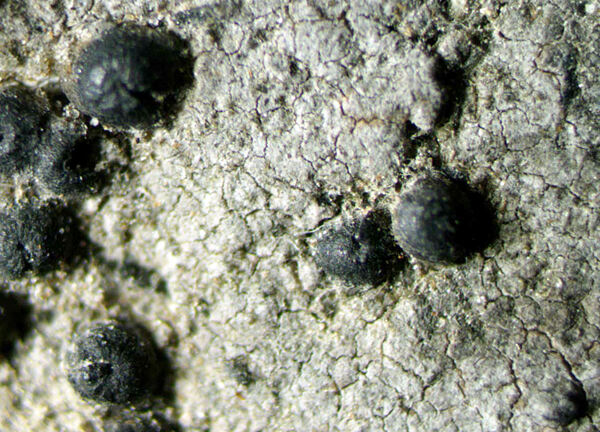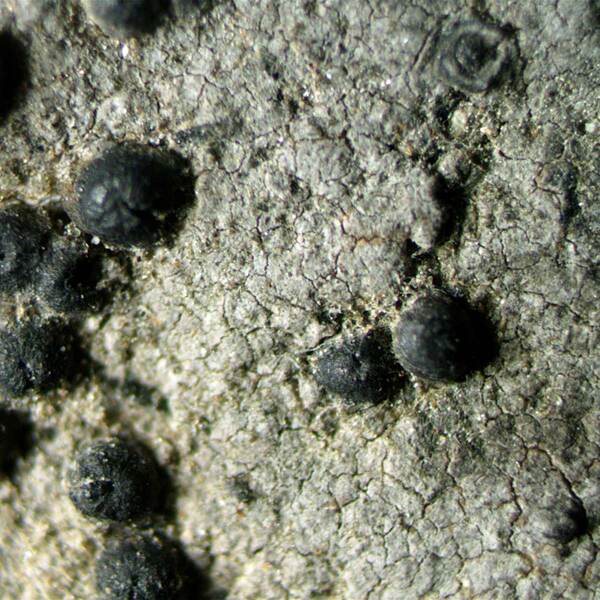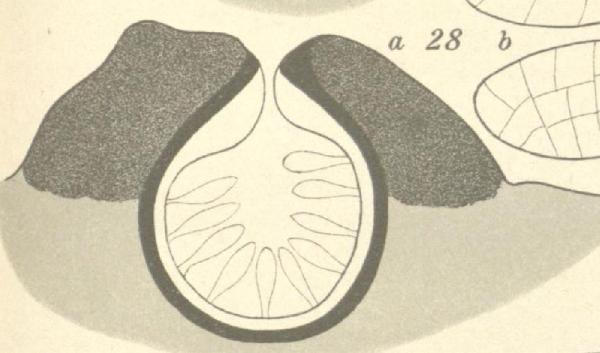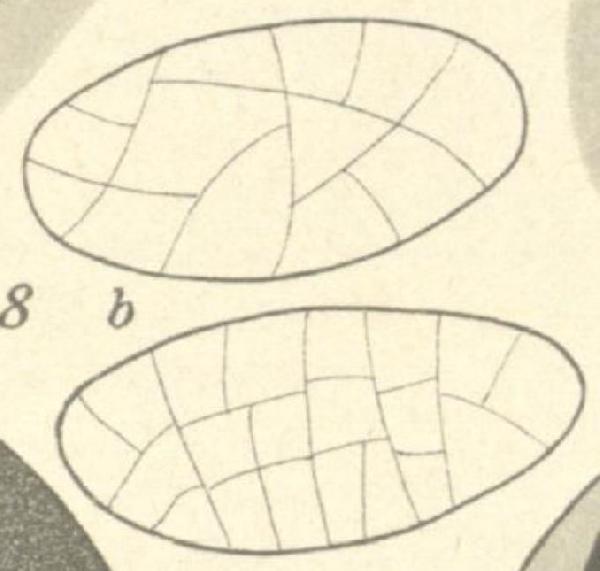Henrica melaspora (Taylor) Savić & Tibell
Nord. J. Bot., 26: 243, 2008. Basionym: Verrucaria melaspora Taylor in Hooker - London J. Bot., 6: 153, 1847.
Synonyms: Polyblastia melaspora (Taylor) Zahlbr.; Polyblastia plotocarpa Zschacke?; Polyblastia scotinospora (Nyl.) Hellb.; Polyblastia subinumbrata (Nyl.) A.L. Sm.; Polyblastia vallorcinensis (Croz.) Zschacke?
Description: Thallus crustose, endosubstratic or thinly episubstratic and rimose-areolate, white to dirty grey, sometimes with a brownish tinge, the areoles 0.3-0.6 mm wide, separated by narrow cracks. Thallus pseudoparenchymatous throughout, the outermost layer forming a thin, colourless pseudocortex of spherical cells; algal cells more or less distinctly arranged in vertical columns separated by strands of mycobiont cells. Perithecia black, 0.5-0.8 mm across, hemispherical to flattened, formed singly or in groups, the ostiolar region often depressed, the outer surface coarsely uneven in upper part, sometimes covered by a very thin thalline layer at the base. Involucrellum reaching down to the thallus, diverging towards the base, gradually thickened toward the base (120-140 µm thick), strongly carbonized; exciple 22-31 µm thick, brown, paraplectenchymatous; hamathecium of thin, c. 1.2 µm wide, sparingly branched pseudoparaphyses, interascal filaments absent; hymenial gel I+ red, K/I+ blue. Asci 8-spored, clavate, without apical thickening when mature. Ascospores muriform, with 5-7 transverse septa and 2-4 longitudinal septa in central part, at first hyaline but soon turning brown, ellipsoid, often slightly asymmetric and curved, 27-39 x 16-20 µm, the surface minutely punctate. Photobiont chlorococcoid. Spot tests: K-, C-, KC-, P-, UV-. Chemistry: without lichen substances.
Growth form: Crustose
Substrata: rocks
Photobiont: green algae other than Trentepohlia
Reproductive strategy: mainly sexual
Commonnes-rarity: (info)
Alpine belt: very rare
Subalpine belt: very rare
Montane belt: absent
Dry submediterranean belt: absent
Humid submediterranean belt: absent
Padanian area: absent
pH of the substrata:
1 2 3 4 5
Solar irradiation:
1 2 3 4 5
Aridity:
1 2 3 4 5
Eutrophication:
1 2 3 4 5
Poleotolerance:
0 1 2 3
Altitudinal distribution:
1 2 3 4 5 6
Rarity
absent
extremely rare
very rare
rare
rather rare
rather common
common
very common
extremely common
Loading data...
Occurrence data
Predictive map

http://fungi.myspecies.info/sites/fungi.myspecies.info/files/Polyblast%20mela4424c.jpg - Licence: CC BY-NC 3. Photo uploaded by Mark Powell

Source: http://fungi.myspecies.info/sites/fungi.myspecies.info/files/Polyblast%20mela4424c.jpg - Licence: CC BY-NC 3. Photo uploaded by Mark Powell

Source: Zschacke H. 1914. Die mitteleuropäsche Verrucariaceen. II. Hedwigia, 55: 286-324. Public Domain
26. P. subinumbrata Orig.: 4 Sporen.
Growth form: Crustose
Substrata: rocks
Photobiont: green algae other than Trentepohlia
Reproductive strategy: mainly sexual
Commonnes-rarity: (info)
Alpine belt: very rare
Subalpine belt: very rare
Montane belt: absent
Dry submediterranean belt: absent
Humid submediterranean belt: absent
Padanian area: absent
pH of the substrata:
| 1 | 2 | 3 | 4 | 5 |
Solar irradiation:
| 1 | 2 | 3 | 4 | 5 |
Aridity:
| 1 | 2 | 3 | 4 | 5 |
Eutrophication:
| 1 | 2 | 3 | 4 | 5 |
Poleotolerance:
| 0 | 1 | 2 | 3 |
Altitudinal distribution:
| 1 | 2 | 3 | 4 | 5 | 6 |
Rarity
absent
extremely rare
very rare
rare
rather rare
rather common
common
very common
extremely common
Loading data...
Occurrence data
Predictive map

http://fungi.myspecies.info/sites/fungi.myspecies.info/files/Polyblast%20mela4424c.jpg - Licence: CC BY-NC 3. Photo uploaded by Mark Powell

Source: http://fungi.myspecies.info/sites/fungi.myspecies.info/files/Polyblast%20mela4424c.jpg - Licence: CC BY-NC 3. Photo uploaded by Mark Powell









